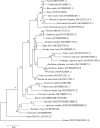Motilin Comparative Study: Structure, Distribution, Receptors, and Gastrointestinal Motility
- PMID: 34497583
- PMCID: PMC8419268
- DOI: 10.3389/fendo.2021.700884
Motilin Comparative Study: Structure, Distribution, Receptors, and Gastrointestinal Motility
Abstract
Motilin, produced in endocrine cells in the mucosa of the upper intestine, is an important regulator of gastrointestinal (GI) motility and mediates the phase III of interdigestive migrating motor complex (MMC) in the stomach of humans, dogs and house musk shrews through the specific motilin receptor (MLN-R). Motilin-induced MMC contributes to the maintenance of normal GI functions and transmits a hunger signal from the stomach to the brain. Motilin has been identified in various mammals, but the physiological roles of motilin in regulating GI motility in these mammals are well not understood due to inconsistencies between studies conducted on different species using a range of experimental conditions. Motilin orthologs have been identified in non-mammalian vertebrates, and the sequence of avian motilin is relatively close to that of mammals, but reptile, amphibian and fish motilins show distinctive different sequences. The MLN-R has also been identified in mammals and non-mammalian vertebrates, and can be divided into two main groups: mammal/bird/reptile/amphibian clade and fish clade. Almost 50 years have passed since discovery of motilin, here we reviewed the structure, distribution, receptor and the GI motility regulatory function of motilin in vertebrates from fish to mammals.
Keywords: comparative biology; enteric nerves; gastrointestinal contractility; motilin; motilin receptor; smooth muscle; vagus afferent nerves.
Copyright © 2021 Kitazawa and Kaiya.
Conflict of interest statement
The authors declare that the research was conducted in the absence of any commercial or financial relationships that could be construed as a potential conflict of interest.
Figures



Similar articles
-
A verification study of gastrointestinal motility-stimulating action of guinea-pig motilin using isolated gastrointestinal strips from rabbits and guinea-pigs.Gen Comp Endocrinol. 2019 Apr 1;274:106-112. doi: 10.1016/j.ygcen.2019.01.010. Epub 2019 Jan 21. Gen Comp Endocrinol. 2019. PMID: 30677392
-
The motilin receptor agonist erythromycin stimulates hunger and food intake through a cholinergic pathway.Am J Clin Nutr. 2016 Mar;103(3):730-7. doi: 10.3945/ajcn.115.113456. Epub 2016 Jan 27. Am J Clin Nutr. 2016. PMID: 26817505 Clinical Trial.
-
Identification of pheasant ghrelin and motilin and their actions on contractility of the isolated gastrointestinal tract.Gen Comp Endocrinol. 2020 Jan 1;285:113294. doi: 10.1016/j.ygcen.2019.113294. Epub 2019 Oct 1. Gen Comp Endocrinol. 2020. PMID: 31585115
-
Motilin: from gastric motility stimulation to hunger signalling.Nat Rev Endocrinol. 2019 Apr;15(4):238-250. doi: 10.1038/s41574-019-0155-0. Nat Rev Endocrinol. 2019. PMID: 30675023 Review.
-
Regulation of Gastrointestinal Motility by Motilin and Ghrelin in Vertebrates.Front Endocrinol (Lausanne). 2019 May 17;10:278. doi: 10.3389/fendo.2019.00278. eCollection 2019. Front Endocrinol (Lausanne). 2019. PMID: 31156548 Free PMC article. Review.
Cited by
-
Structural basis for motilin and erythromycin recognition by motilin receptor.Sci Adv. 2023 Mar 17;9(11):eade9020. doi: 10.1126/sciadv.ade9020. Epub 2023 Mar 15. Sci Adv. 2023. PMID: 36921049 Free PMC article.
-
The role of prokinetics in managing gastrointestinal involvement in SSc: a systematic literature review.Rheumatology (Oxford). 2025 Jun 1;64(6):3266-3279. doi: 10.1093/rheumatology/keaf064. Rheumatology (Oxford). 2025. PMID: 39909554
-
Motilin and its receptor are expressed in the dorsal horn in a rat model of acute incisional pain: Intrathecal motilin injection alleviates pain behaviors.Front Neurosci. 2023 Feb 2;17:1104862. doi: 10.3389/fnins.2023.1104862. eCollection 2023. Front Neurosci. 2023. PMID: 36816129 Free PMC article.
-
Common Pathophysiological Mechanisms and Treatment of Diabetic Gastroparesis.J Neurogastroenterol Motil. 2024 Apr 30;30(2):143-155. doi: 10.5056/jnm23100. J Neurogastroenterol Motil. 2024. PMID: 38576367 Free PMC article. Review.
-
Why is motilin active in some studies with mice, rats, and guinea pigs, but not in others? Implications for functional variability among rodents.Pharmacol Res Perspect. 2022 Apr;10(2):e00900. doi: 10.1002/prp2.900. Pharmacol Res Perspect. 2022. PMID: 35191209 Free PMC article. Review.
References
-
- Brown JC, Cook MA, Dryburgh JR. Motilin, A Gastric Motor Activity-Stimulating Polypeptide: Final Purification, Amino Acid Composition, and C-Terminal Residues. Gastroenterology (1972) 62:401–4. - PubMed
Publication types
MeSH terms
Substances
LinkOut - more resources
Full Text Sources
Molecular Biology Databases

